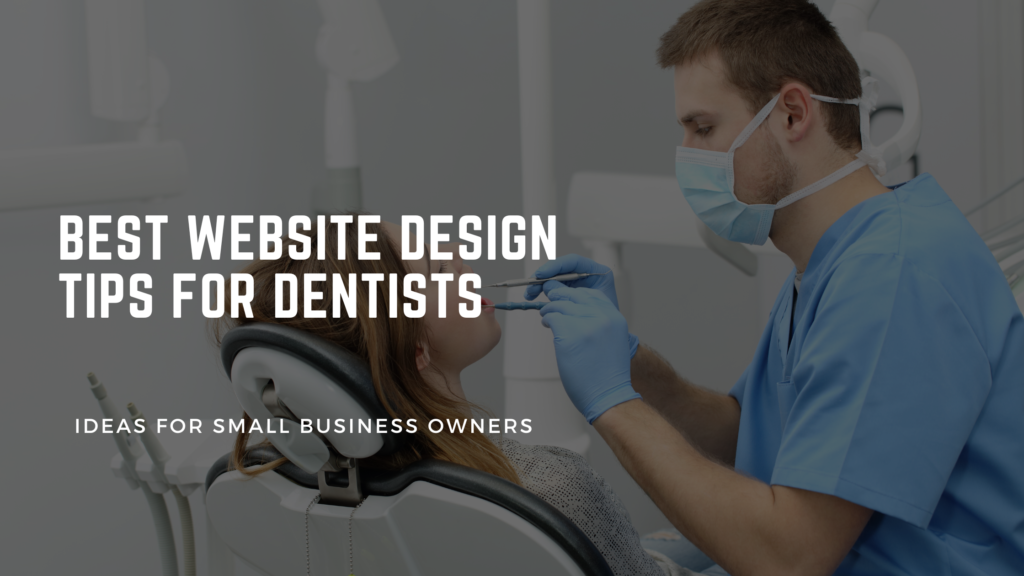A well-designed website is crucial for any modern dental practice. It not only helps build trust with potential patients but also serves as a tool for managing appointments and providing essential information about your services. In an age where most people turn to the internet to find healthcare providers, having a professional and user-friendly dental website is a must.
In this blog, we’ll explore the best website design tips for dentists to help you attract new patients, boost engagement, and provide a seamless experience for visitors.

1. Prioritize a Clean and Professional Design
Your website is often the first impression potential patients will have of your practice. A clean, professional design can help you build trust from the moment someone lands on your site. Avoid clutter, unnecessary distractions, or outdated design elements that could make your practice appear unprofessional.
Key Elements of a Clean Design:
- Simple layout: Stick to a clean, minimalistic layout with clear navigation.
- High-quality images: Use professional photos of your practice, staff, and treatment rooms to make a welcoming first impression.
- Readable fonts: Choose easy-to-read fonts in a size that is comfortable for all users, and stick to a limited color palette that reflects your brand.
Pro Tip: Ensure your logo and branding are consistent across your website to create a cohesive, professional look.
2. Make Navigation Intuitive
Patients visiting your website are likely looking for specific information, such as services, office hours, or booking options. Make sure your website is easy to navigate by organizing information in a clear, logical manner.
Key Tips for Intuitive Navigation:
- Use a simple menu: Your menu should be easy to find and clearly labeled with essential sections like “Services,” “About Us,” “Book an Appointment,” and “Contact Us.”
- Minimize clicks: Reduce the number of clicks it takes to find important information. Patients should be able to schedule an appointment or find contact details in just one or two clicks.
- Include a search function: A search bar can help patients find specific services or information quickly.
Pro Tip: Test your navigation with a few friends or family members to ensure they can easily find what they need within seconds.
3. Optimize for Mobile Devices
With most patients browsing on smartphones or tablets, having a mobile-friendly website is essential. A mobile-optimized design ensures that your website looks and functions well on any device, preventing users from getting frustrated and leaving your site.

How to Optimize for Mobile:
- Responsive design: Ensure that your website adjusts automatically to different screen sizes without losing functionality or aesthetics.
- Touch-friendly buttons: Make sure all buttons and links are large enough to be tapped easily on a mobile device.
- Fast loading times: Optimize images and minimize code to ensure your website loads quickly, even on mobile connections.
Pro Tip: Use Google’s Mobile-Friendly Test to check how well your website performs on mobile devices.
4. Highlight Your Services
One of the most important pages on a dental website is the Services page. Potential patients want to know what treatments you offer and whether your practice can address their dental needs. Provide clear, concise descriptions of your services, and include relevant details such as what to expect during a procedure.
Best Practices for Highlighting Services:
- Break services into categories: Organize services into categories such as General Dentistry, Cosmetic Dentistry, and Orthodontics to make it easy for patients to find what they need.
- Use layman’s terms: Avoid using overly technical language. Instead, explain dental procedures in simple terms that anyone can understand.
- Include visuals: Add images, diagrams, or even short videos that explain how procedures work, helping to ease any concerns or fears.
Pro Tip: Include a call-to-action (CTA) on each service page, such as “Book an Appointment” or “Contact Us for More Information.”
5. Incorporate Online Booking
Patients value convenience, and one of the most effective ways to engage them is by offering online appointment scheduling. A well-placed “Book an Appointment” button that links to a user-friendly booking system will make it easy for patients to schedule their visits without needing to call your office.
Key Features for Online Booking:
- Real-time availability: Show your availability in real time, so patients can choose the most convenient time slots.
- Automated reminders: Integrate appointment reminders via email or SMS to reduce no-shows.
- Mobile compatibility: Ensure the booking system is mobile-friendly for patients on the go.
Pro Tip: Place the “Book an Appointment” button prominently on your homepage and service pages to make it easy for patients to find.
6. Showcase Positive Reviews and Testimonials
Positive patient reviews and testimonials play a huge role in building trust with potential patients. Featuring these on your website can reassure visitors that they are making the right choice by choosing your dental practice.
Where to Showcase Reviews:
- On the homepage: Include a few standout testimonials on your homepage to make a strong first impression.
- On a dedicated page: Create a separate page for reviews and patient testimonials. Include written reviews, star ratings, and even video testimonials if available.
- In Google snippets: Use structured data to display star ratings directly in Google search results.
Pro Tip: Ask satisfied patients to leave reviews on platforms like Google or Yelp, and include links to these reviews on your website.
7. Provide Educational Content
Patients often have questions about dental procedures, treatments, and oral hygiene. Offering educational content on your website can position you as an expert and build trust with your audience. This content can take the form of blog posts, FAQs, or downloadable guides.
Ideas for Educational Content:
- Blog posts: Write articles on topics like “How to Care for Your Teeth After a Whitening Treatment” or “5 Signs You Need to See a Dentist.”
- FAQs: Create a FAQ section that answers common questions about your services, payment options, and what to expect during visits.
- Video content: Create short explainer videos on topics like brushing techniques, flossing tips, or what to expect during a root canal.
Pro Tip: Regularly update your blog or content section with seasonal or trending topics to keep patients engaged and coming back to your site for valuable information.
8. Make Contact Information Easily Accessible
It should be easy for patients to find your contact information, whether they’re looking to call your office, get directions, or send a message. Make sure your contact details are clearly displayed on every page of your website.
Best Practices for Contact Information:
- Header and footer placement: Include your phone number, address, and email in both the header and footer of every page.
- Contact page: Create a dedicated contact page with a form for inquiries, your office address, phone number, email, and a Google Maps widget for easy navigation.
- Clickable phone numbers: For mobile users, ensure your phone number is clickable so they can call your office directly from their phone.
Pro Tip: Include your hours of operation on your contact page, so patients know when they can reach your office.
Final Thoughts
A well-designed dental website can make a world of difference when it comes to attracting and retaining patients. By focusing on a clean design, intuitive navigation, mobile optimization, and patient-friendly features like online booking and educational content, you can create a website that enhances the patient experience and helps grow your practice.
At Square Page Digital, we specialize in building engaging, high-converting websites for dental practices. Contact us today to learn how we can help you create a modern, user-friendly website that drives patient engagement and appointments.

